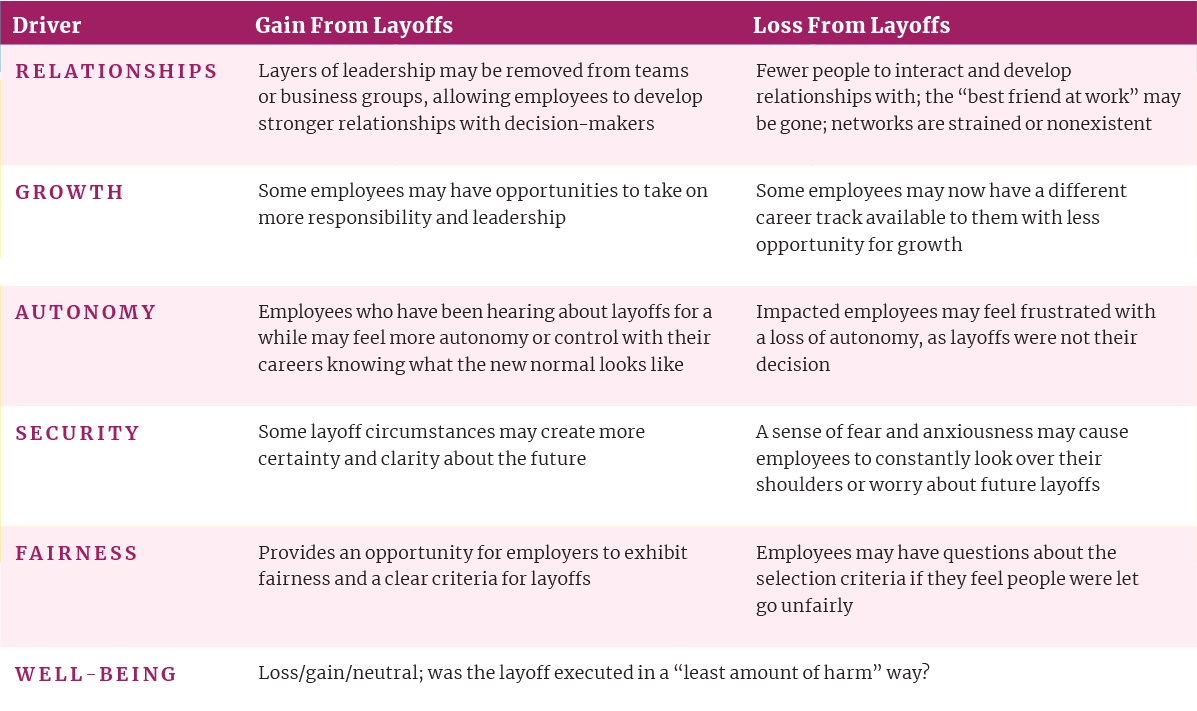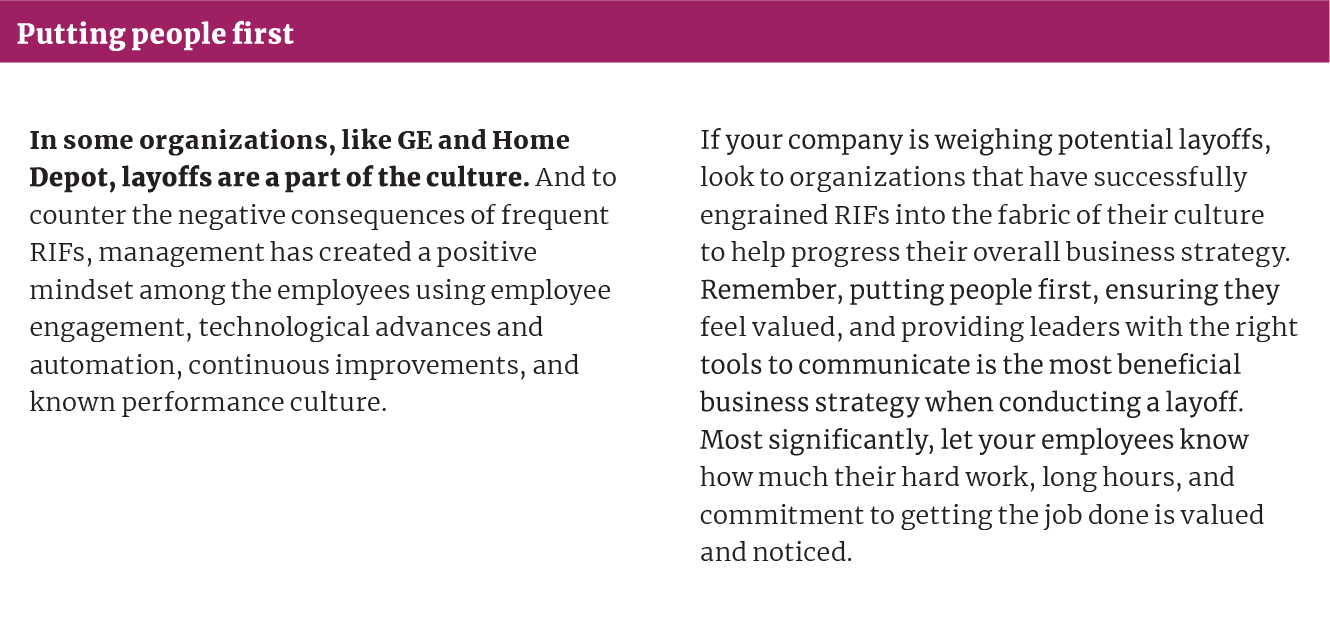Layoffs, also known as reductions in force (RIF), are usually preempted by a series of events and driven by profitability. As companies deal with the fallout of major crises, macro-global impacts to their businesses, or a shift in consumer needs, executives must evaluate the sustainability of their workforce if supply does not equal demand.
There’s no one definitive way to effectively execute a RIF. As organizations consider the massive impacts of a layoff on their corporate structure, employee productivity, and company culture, various approaches will likely emerge for handling the process. As leadership teams lay out their RIF strategy, it is important to remember that each choice they make will likely have unintended consequences, both positive and negative. The prospect of reducing the workforce of any organization is daunting, and the impact to individuals and families is impossible to plan for, calculate, or ignore.
This article outlines the best practices a leadership team should follow when considering or executing a RIF, as well as how to deal with many of the unintended consequences associated with laying off employees.
Define Your Value and Culture
The decision to carry out a RIF is not one an executive wants to make. But whether you lead a large organization or a small team, the decisions you make before and after a RIF are critical to showcasing your personal principles and the organization’s culture. How you position and handle layoffs will be seen as a reflection of what you believe — no matter what you say. The way you carry out a RIF will leave lasting impacts on both the employees who have been laid off and those who remain.
Bottom line: How your organization treats its employees throughout the RIF process is a direct reflection of the organization’s culture and will define you in the market beyond the RIF event.
Weigh the Consequences
There are many consequences — both intended and unintended — that stem from reducing your organization’s workforce. As you consider layoffs, clearly think through all the ramifications of the decision before settling on a strategy.
Intended Consequences (Aftermath)
- Higher performance standards among those still employed
- Market competitiveness
- Increased focus on strategic priorities/business model
Unintended Consequences (Aftermath)
-
Low morale
-
Survivor’s guilt
-
Litigation, if perceived not to be done fairly
-
Lack of clarity about why certain employees were kept
-
Less trust of executives and company from retained employees
-
Loss of institutional knowledge and/or informal relationship network
-
Increased cost due to increased attrition of those you wanted/needed to keep
While layoffs are not ideal, if employees experience compassion, advocacy, and support from management during the process, they will likely share that with colleagues as they depart.
The intended consequences of layoffs are straightforward and typically designed to meet the financial needs of your organization, especially in a downturn market economy. However, when RIF day comes and your employees see that their colleagues are no longer in the office — or in our virtual world, no longer on the screen — the impacts to morale and engagement are immediate.
After a RIF, remaining employees may be glad they are “safe” and “made the cut,” but they will continue to wonder if another round of layoffs is coming — and if so, are they next? As a result, productivity may spike for a short period of time as employees strive to create a perceived safety net for themselves. They may think, “The more I do, the greater value I bring to my organization, and therefore I’m reducing the chance of being laid off next.” This type of employee behavior is not sustainable and often leads to burnout.
Conversely, employees are sometimes expected to take on more work with fewer resources in the wake of their colleagues’ termination. If employees are distracted, demoralized, and overburdened, larger organizational concerns may rise to the surface. In both cases, keeping employees engaged should be a top priority during layoffs. The productivity bubble will burst sooner or later. When the bubble does burst, declines in engagement and performance will impact a workforce that has likely already been reduced in capacity and production ability by layoffs.
As companies evaluate their workforce and where to make cuts, they should also evaluate the actual work being done. When headcounts are reduced, it’s important to remember that outputs will also need to decrease. Employers need to make sure they focus on maintaining value-added work and the associated workforce.
Bottom line: Employee burnout is a key unintended consequence of a RIF. Employers should place a high amount of focus on employee engagement and value-added work, while striving to eliminate the work that isn’t critical for the immediate period of time.
Consider the Drivers of Engagement
As leaders around the world evaluate the size of their workforces in the midst of a pandemic, as well as in the post-pandemic economy, the real question becomes: When are layoffs the appropriate response to economic realities, and how can leadership support, engage, and promote those who are left to pick up the pieces?
Jabian’s Engagement Framework identifies the levers an organization can pull to increase employee engagement. As your organization considers a layoff, consider the impacts to each engagement driver and the resulting possible gain or loss.

Encourage and Inspire (Relationships, Growth)
It is critical to encourage and inspire your teams during layoffs. One of the ways to keep employees engaged is to create opportunities for greater responsibility, scope, or leadership. As business focus evolves, employees may have an opportunity to move into a different area of the company, to wear multiple hats and grow professional skills, and, ultimately, to advance more quickly in their careers. By recognizing your employees’ value, you can implement a strong support system with robust knowledge transfer in place for remaining employees.
Communicate and Communicate and Communicate Again (Security, Well-Being)
Employee engagement and maintaining a continuity of positive behaviors that drive organizational culture are critical in the aftermath of a layoff. Some of the immediate questions you should be prepared to answer include:
- The 1:1 — How am I being impacted?
I want to know before the whole world knows. - The Team — What does this mean for my team? Does having fewer people on the team mean more work for us? What about scope? What about knowledge/transition? What if we are in the middle of a project?
- The Enterprise — This is all about the “Why.” What is the business looking to gain from layoffs? Why are they necessary right now? What happens next?

Determine the Sequence of Communications
Who is told first? What messaging is confidential (or at least until all impacted individuals know)? Create talking points for your team managers to keep the messaging consistent, but make sure managers understand it’s OK to say “I don’t know” or not be able to answer some questions. Consistency in the messaging mitigates litigation.
Remaining employees can feel uneasy about their own job security as well as the organization’s future. Their concerns are reasonable given that times are uncertain and many organizations are rethinking their operating and talent models. Under these circumstances, leaders should regularly share directional ideas for the future, as well as progress updates on how the organization is doing toward meeting these targets and goals.
During stressful times, it’s better to err on the side of overcommunicating. In the absence of constant communications, employees may think leaders are not aligned or that they are purposely being secretive. Rumor mills often begin in a communication vacuum with messages that might be inaccurate or designed to demoralize. Transparent and regular communications from leadership provide stability, assurance, and give employees optimism and a plan for the path ahead.
Handle With Care (Relationships, Fairness)
For the newest alumni of the organization, how they are treated throughout the RIF process will shape their lasting sentiments about the organization — regardless of length of tenure. When you instill the guiding principle of “do little harm,” laid-off employees will, hopefully, continue to advocate for the company both during and after their departure.
While layoffs are not ideal, if employees experience compassion, advocacy, and support from management during the process, they will likely share that with colleagues as they depart. Similarly, if employees being laid off are not treated well, you can expect to see reviews on job- and company-related websites highlighting their negative experience. These negative stigmas can be challenging, time consuming, and costly to overcome.
The best ways to support your workforce during this difficult time is to provide them with the support and respect they deserve. Consider providing outplacement services to help them make their next move more seamless. Additionally, who delivers the message will impact how it is received — especially considering the nature of this virtual and remote world. When possible, direct leaders should deliver RIF messages to the employee on an individual basis.
